Report: Financial and Economic Literacy for Managers (Finance Module)
VerifiedAdded on 2020/01/21
|11
|2186
|341
Report
AI Summary
This report delves into the crucial aspects of financial and economic literacy essential for effective management. It begins by examining the impact of globalization on consumers and firms, followed by an analysis of demand curves and the comparison of economies and diseconomies of scale. The report also explores the determinants of supply and contrasts substitute and complementary goods. Furthermore, it addresses imperfect competition markets, barriers to entry, and environmental policies related to market failures. The report then covers the circular flow of income and macroeconomic concepts such as unemployment. Financial statements, including their format and purpose, are discussed, along with ratio analysis, management accounting phases, and relevant versus irrelevant costs. Finally, the report examines risk and return concepts, capital structure, amortization schedules, and project selection, including NPV calculations, providing a comprehensive overview of financial and economic principles for managerial decision-making.

Financial and
Economic Literacy for
Managers
1
Economic Literacy for
Managers
1
Paraphrase This Document
Need a fresh take? Get an instant paraphrase of this document with our AI Paraphraser
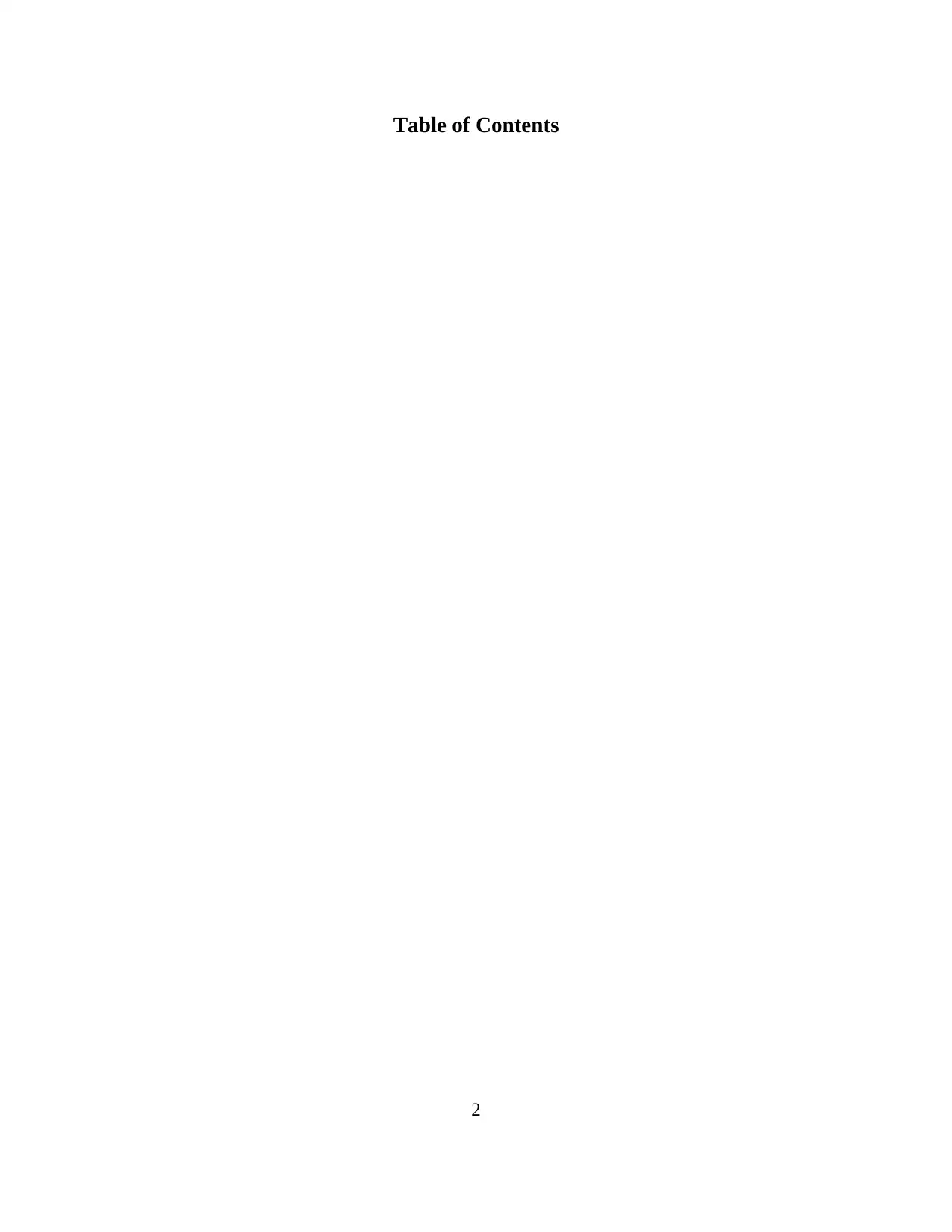
Table of Contents
2
2
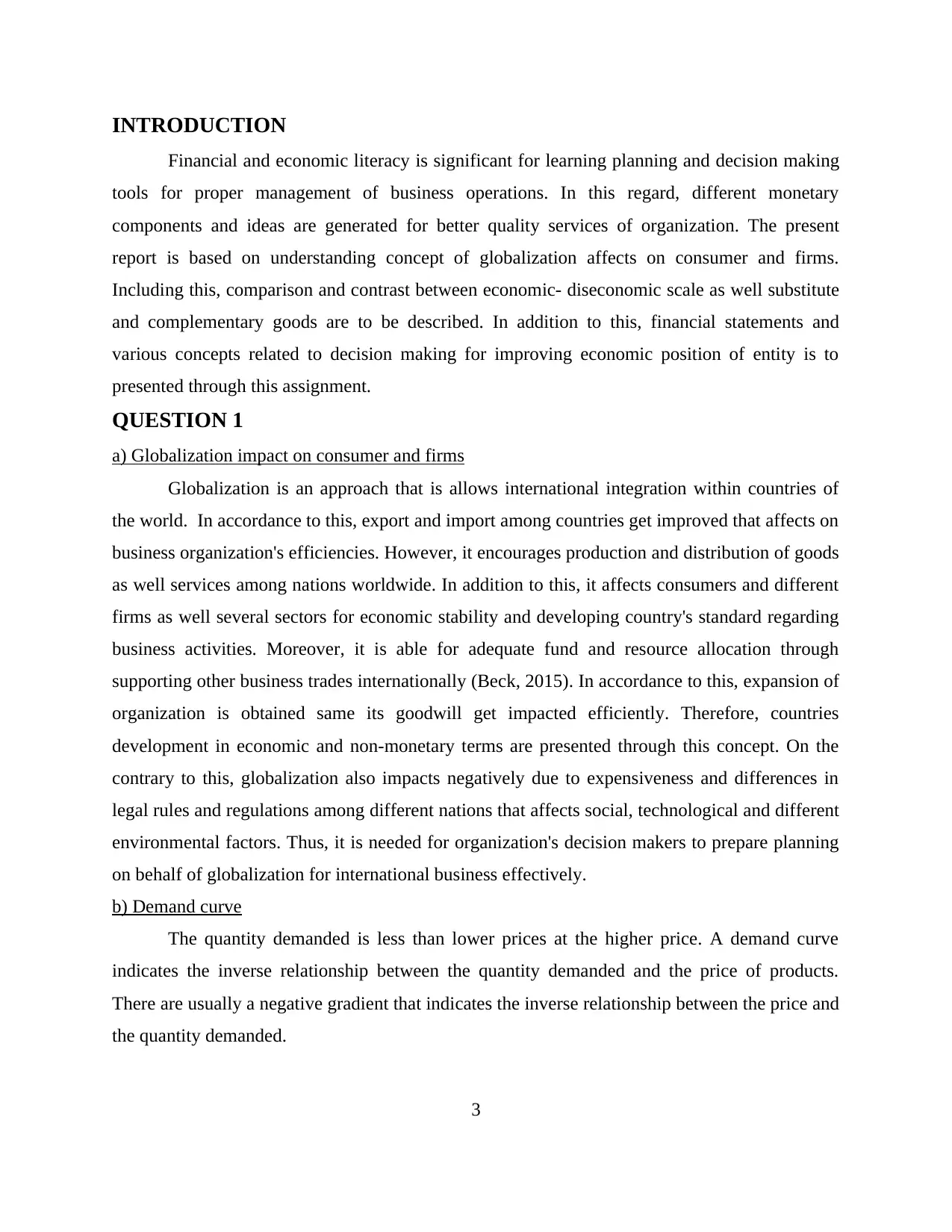
INTRODUCTION
Financial and economic literacy is significant for learning planning and decision making
tools for proper management of business operations. In this regard, different monetary
components and ideas are generated for better quality services of organization. The present
report is based on understanding concept of globalization affects on consumer and firms.
Including this, comparison and contrast between economic- diseconomic scale as well substitute
and complementary goods are to be described. In addition to this, financial statements and
various concepts related to decision making for improving economic position of entity is to
presented through this assignment.
QUESTION 1
a) Globalization impact on consumer and firms
Globalization is an approach that is allows international integration within countries of
the world. In accordance to this, export and import among countries get improved that affects on
business organization's efficiencies. However, it encourages production and distribution of goods
as well services among nations worldwide. In addition to this, it affects consumers and different
firms as well several sectors for economic stability and developing country's standard regarding
business activities. Moreover, it is able for adequate fund and resource allocation through
supporting other business trades internationally (Beck, 2015). In accordance to this, expansion of
organization is obtained same its goodwill get impacted efficiently. Therefore, countries
development in economic and non-monetary terms are presented through this concept. On the
contrary to this, globalization also impacts negatively due to expensiveness and differences in
legal rules and regulations among different nations that affects social, technological and different
environmental factors. Thus, it is needed for organization's decision makers to prepare planning
on behalf of globalization for international business effectively.
b) Demand curve
The quantity demanded is less than lower prices at the higher price. A demand curve
indicates the inverse relationship between the quantity demanded and the price of products.
There are usually a negative gradient that indicates the inverse relationship between the price and
the quantity demanded.
3
Financial and economic literacy is significant for learning planning and decision making
tools for proper management of business operations. In this regard, different monetary
components and ideas are generated for better quality services of organization. The present
report is based on understanding concept of globalization affects on consumer and firms.
Including this, comparison and contrast between economic- diseconomic scale as well substitute
and complementary goods are to be described. In addition to this, financial statements and
various concepts related to decision making for improving economic position of entity is to
presented through this assignment.
QUESTION 1
a) Globalization impact on consumer and firms
Globalization is an approach that is allows international integration within countries of
the world. In accordance to this, export and import among countries get improved that affects on
business organization's efficiencies. However, it encourages production and distribution of goods
as well services among nations worldwide. In addition to this, it affects consumers and different
firms as well several sectors for economic stability and developing country's standard regarding
business activities. Moreover, it is able for adequate fund and resource allocation through
supporting other business trades internationally (Beck, 2015). In accordance to this, expansion of
organization is obtained same its goodwill get impacted efficiently. Therefore, countries
development in economic and non-monetary terms are presented through this concept. On the
contrary to this, globalization also impacts negatively due to expensiveness and differences in
legal rules and regulations among different nations that affects social, technological and different
environmental factors. Thus, it is needed for organization's decision makers to prepare planning
on behalf of globalization for international business effectively.
b) Demand curve
The quantity demanded is less than lower prices at the higher price. A demand curve
indicates the inverse relationship between the quantity demanded and the price of products.
There are usually a negative gradient that indicates the inverse relationship between the price and
the quantity demanded.
3
⊘ This is a preview!⊘
Do you want full access?
Subscribe today to unlock all pages.

Trusted by 1+ million students worldwide
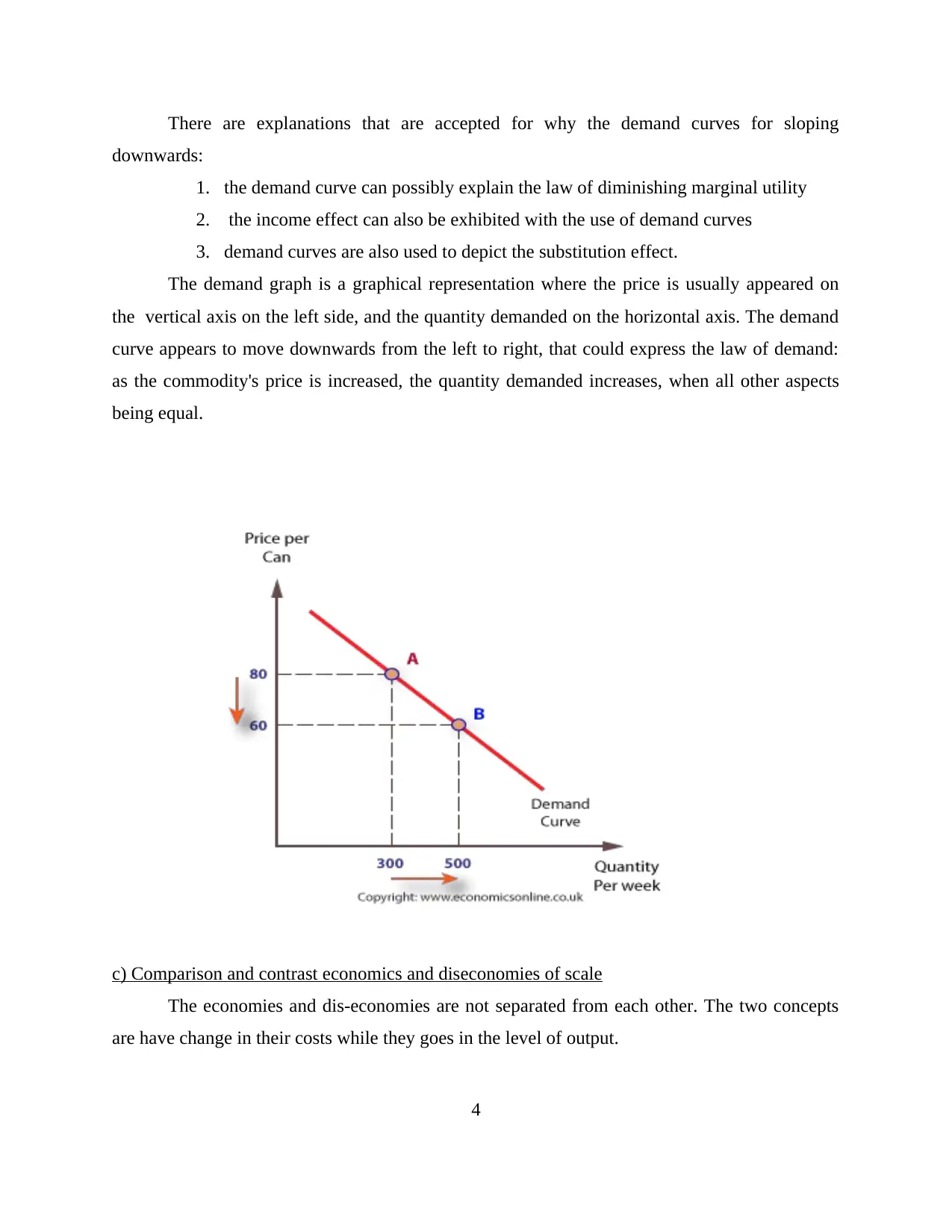
There are explanations that are accepted for why the demand curves for sloping
downwards:
1. the demand curve can possibly explain the law of diminishing marginal utility
2. the income effect can also be exhibited with the use of demand curves
3. demand curves are also used to depict the substitution effect.
The demand graph is a graphical representation where the price is usually appeared on
the vertical axis on the left side, and the quantity demanded on the horizontal axis. The demand
curve appears to move downwards from the left to right, that could express the law of demand:
as the commodity's price is increased, the quantity demanded increases, when all other aspects
being equal.
c) Comparison and contrast economics and diseconomies of scale
The economies and dis-economies are not separated from each other. The two concepts
are have change in their costs while they goes in the level of output.
4
downwards:
1. the demand curve can possibly explain the law of diminishing marginal utility
2. the income effect can also be exhibited with the use of demand curves
3. demand curves are also used to depict the substitution effect.
The demand graph is a graphical representation where the price is usually appeared on
the vertical axis on the left side, and the quantity demanded on the horizontal axis. The demand
curve appears to move downwards from the left to right, that could express the law of demand:
as the commodity's price is increased, the quantity demanded increases, when all other aspects
being equal.
c) Comparison and contrast economics and diseconomies of scale
The economies and dis-economies are not separated from each other. The two concepts
are have change in their costs while they goes in the level of output.
4
Paraphrase This Document
Need a fresh take? Get an instant paraphrase of this document with our AI Paraphraser
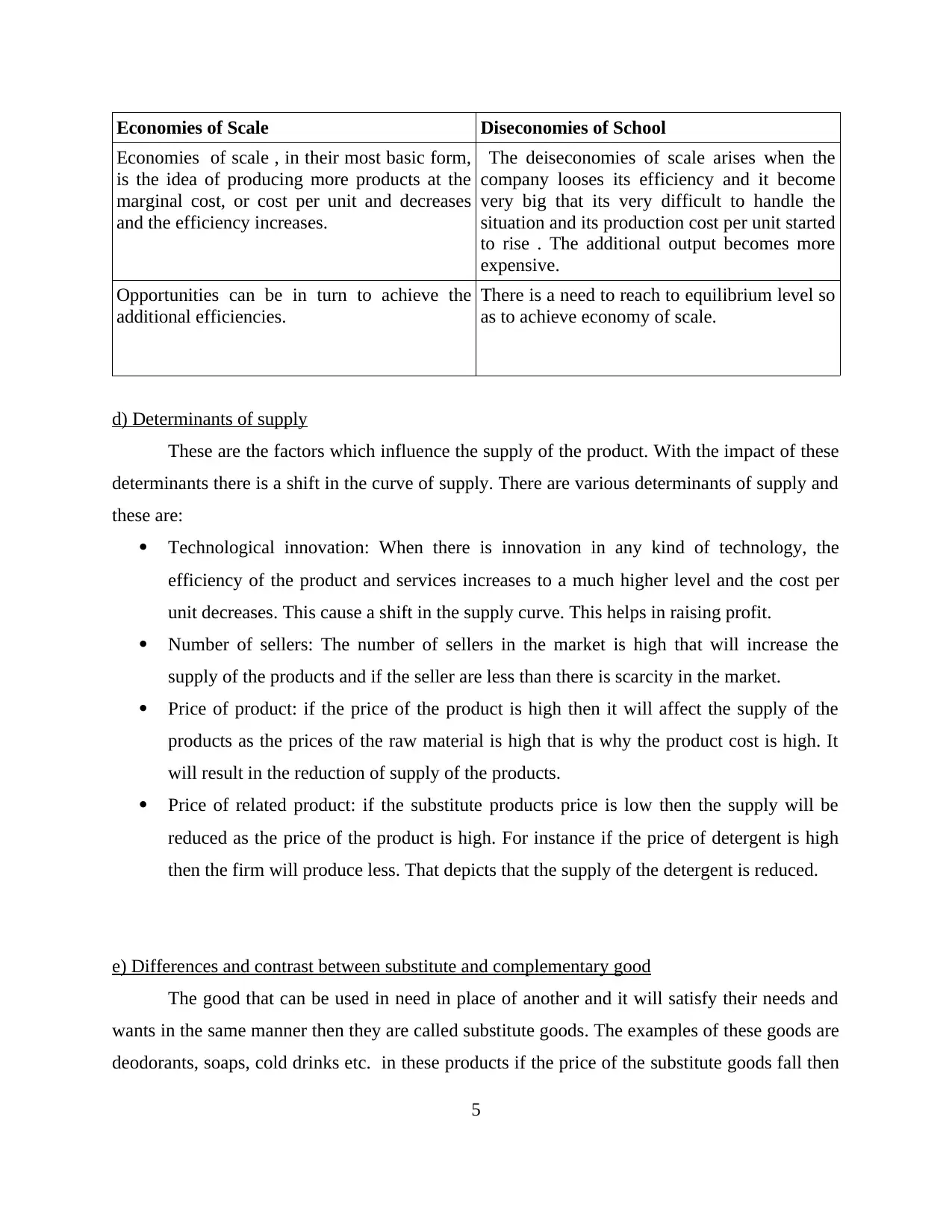
Economies of Scale Diseconomies of School
Economies of scale , in their most basic form,
is the idea of producing more products at the
marginal cost, or cost per unit and decreases
and the efficiency increases.
The deiseconomies of scale arises when the
company looses its efficiency and it become
very big that its very difficult to handle the
situation and its production cost per unit started
to rise . The additional output becomes more
expensive.
Opportunities can be in turn to achieve the
additional efficiencies.
There is a need to reach to equilibrium level so
as to achieve economy of scale.
d) Determinants of supply
These are the factors which influence the supply of the product. With the impact of these
determinants there is a shift in the curve of supply. There are various determinants of supply and
these are:
Technological innovation: When there is innovation in any kind of technology, the
efficiency of the product and services increases to a much higher level and the cost per
unit decreases. This cause a shift in the supply curve. This helps in raising profit.
Number of sellers: The number of sellers in the market is high that will increase the
supply of the products and if the seller are less than there is scarcity in the market.
Price of product: if the price of the product is high then it will affect the supply of the
products as the prices of the raw material is high that is why the product cost is high. It
will result in the reduction of supply of the products.
Price of related product: if the substitute products price is low then the supply will be
reduced as the price of the product is high. For instance if the price of detergent is high
then the firm will produce less. That depicts that the supply of the detergent is reduced.
e) Differences and contrast between substitute and complementary good
The good that can be used in need in place of another and it will satisfy their needs and
wants in the same manner then they are called substitute goods. The examples of these goods are
deodorants, soaps, cold drinks etc. in these products if the price of the substitute goods fall then
5
Economies of scale , in their most basic form,
is the idea of producing more products at the
marginal cost, or cost per unit and decreases
and the efficiency increases.
The deiseconomies of scale arises when the
company looses its efficiency and it become
very big that its very difficult to handle the
situation and its production cost per unit started
to rise . The additional output becomes more
expensive.
Opportunities can be in turn to achieve the
additional efficiencies.
There is a need to reach to equilibrium level so
as to achieve economy of scale.
d) Determinants of supply
These are the factors which influence the supply of the product. With the impact of these
determinants there is a shift in the curve of supply. There are various determinants of supply and
these are:
Technological innovation: When there is innovation in any kind of technology, the
efficiency of the product and services increases to a much higher level and the cost per
unit decreases. This cause a shift in the supply curve. This helps in raising profit.
Number of sellers: The number of sellers in the market is high that will increase the
supply of the products and if the seller are less than there is scarcity in the market.
Price of product: if the price of the product is high then it will affect the supply of the
products as the prices of the raw material is high that is why the product cost is high. It
will result in the reduction of supply of the products.
Price of related product: if the substitute products price is low then the supply will be
reduced as the price of the product is high. For instance if the price of detergent is high
then the firm will produce less. That depicts that the supply of the detergent is reduced.
e) Differences and contrast between substitute and complementary good
The good that can be used in need in place of another and it will satisfy their needs and
wants in the same manner then they are called substitute goods. The examples of these goods are
deodorants, soaps, cold drinks etc. in these products if the price of the substitute goods fall then
5
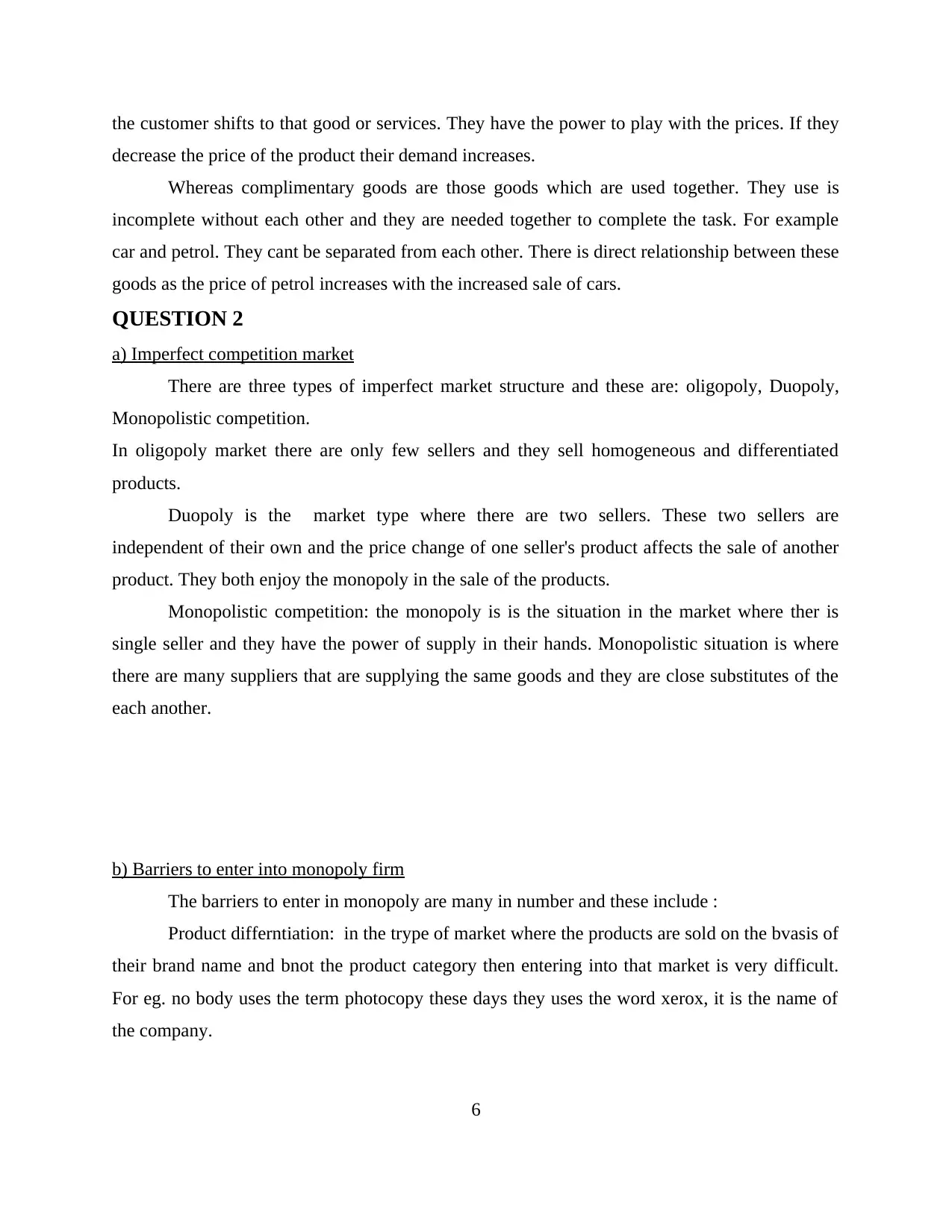
the customer shifts to that good or services. They have the power to play with the prices. If they
decrease the price of the product their demand increases.
Whereas complimentary goods are those goods which are used together. They use is
incomplete without each other and they are needed together to complete the task. For example
car and petrol. They cant be separated from each other. There is direct relationship between these
goods as the price of petrol increases with the increased sale of cars.
QUESTION 2
a) Imperfect competition market
There are three types of imperfect market structure and these are: oligopoly, Duopoly,
Monopolistic competition.
In oligopoly market there are only few sellers and they sell homogeneous and differentiated
products.
Duopoly is the market type where there are two sellers. These two sellers are
independent of their own and the price change of one seller's product affects the sale of another
product. They both enjoy the monopoly in the sale of the products.
Monopolistic competition: the monopoly is is the situation in the market where ther is
single seller and they have the power of supply in their hands. Monopolistic situation is where
there are many suppliers that are supplying the same goods and they are close substitutes of the
each another.
b) Barriers to enter into monopoly firm
The barriers to enter in monopoly are many in number and these include :
Product differntiation: in the trype of market where the products are sold on the bvasis of
their brand name and bnot the product category then entering into that market is very difficult.
For eg. no body uses the term photocopy these days they uses the word xerox, it is the name of
the company.
6
decrease the price of the product their demand increases.
Whereas complimentary goods are those goods which are used together. They use is
incomplete without each other and they are needed together to complete the task. For example
car and petrol. They cant be separated from each other. There is direct relationship between these
goods as the price of petrol increases with the increased sale of cars.
QUESTION 2
a) Imperfect competition market
There are three types of imperfect market structure and these are: oligopoly, Duopoly,
Monopolistic competition.
In oligopoly market there are only few sellers and they sell homogeneous and differentiated
products.
Duopoly is the market type where there are two sellers. These two sellers are
independent of their own and the price change of one seller's product affects the sale of another
product. They both enjoy the monopoly in the sale of the products.
Monopolistic competition: the monopoly is is the situation in the market where ther is
single seller and they have the power of supply in their hands. Monopolistic situation is where
there are many suppliers that are supplying the same goods and they are close substitutes of the
each another.
b) Barriers to enter into monopoly firm
The barriers to enter in monopoly are many in number and these include :
Product differntiation: in the trype of market where the products are sold on the bvasis of
their brand name and bnot the product category then entering into that market is very difficult.
For eg. no body uses the term photocopy these days they uses the word xerox, it is the name of
the company.
6
⊘ This is a preview!⊘
Do you want full access?
Subscribe today to unlock all pages.

Trusted by 1+ million students worldwide
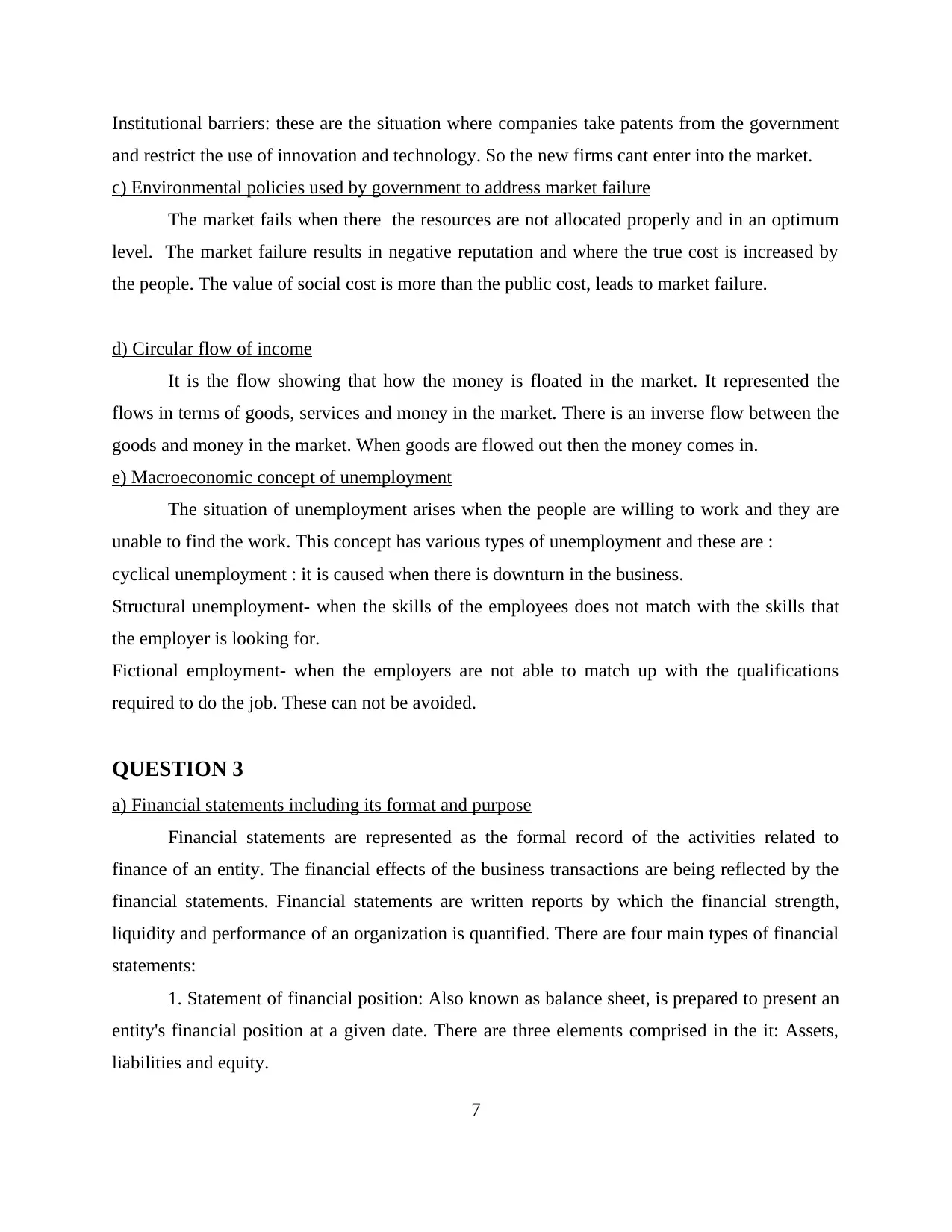
Institutional barriers: these are the situation where companies take patents from the government
and restrict the use of innovation and technology. So the new firms cant enter into the market.
c) Environmental policies used by government to address market failure
The market fails when there the resources are not allocated properly and in an optimum
level. The market failure results in negative reputation and where the true cost is increased by
the people. The value of social cost is more than the public cost, leads to market failure.
d) Circular flow of income
It is the flow showing that how the money is floated in the market. It represented the
flows in terms of goods, services and money in the market. There is an inverse flow between the
goods and money in the market. When goods are flowed out then the money comes in.
e) Macroeconomic concept of unemployment
The situation of unemployment arises when the people are willing to work and they are
unable to find the work. This concept has various types of unemployment and these are :
cyclical unemployment : it is caused when there is downturn in the business.
Structural unemployment- when the skills of the employees does not match with the skills that
the employer is looking for.
Fictional employment- when the employers are not able to match up with the qualifications
required to do the job. These can not be avoided.
QUESTION 3
a) Financial statements including its format and purpose
Financial statements are represented as the formal record of the activities related to
finance of an entity. The financial effects of the business transactions are being reflected by the
financial statements. Financial statements are written reports by which the financial strength,
liquidity and performance of an organization is quantified. There are four main types of financial
statements:
1. Statement of financial position: Also known as balance sheet, is prepared to present an
entity's financial position at a given date. There are three elements comprised in the it: Assets,
liabilities and equity.
7
and restrict the use of innovation and technology. So the new firms cant enter into the market.
c) Environmental policies used by government to address market failure
The market fails when there the resources are not allocated properly and in an optimum
level. The market failure results in negative reputation and where the true cost is increased by
the people. The value of social cost is more than the public cost, leads to market failure.
d) Circular flow of income
It is the flow showing that how the money is floated in the market. It represented the
flows in terms of goods, services and money in the market. There is an inverse flow between the
goods and money in the market. When goods are flowed out then the money comes in.
e) Macroeconomic concept of unemployment
The situation of unemployment arises when the people are willing to work and they are
unable to find the work. This concept has various types of unemployment and these are :
cyclical unemployment : it is caused when there is downturn in the business.
Structural unemployment- when the skills of the employees does not match with the skills that
the employer is looking for.
Fictional employment- when the employers are not able to match up with the qualifications
required to do the job. These can not be avoided.
QUESTION 3
a) Financial statements including its format and purpose
Financial statements are represented as the formal record of the activities related to
finance of an entity. The financial effects of the business transactions are being reflected by the
financial statements. Financial statements are written reports by which the financial strength,
liquidity and performance of an organization is quantified. There are four main types of financial
statements:
1. Statement of financial position: Also known as balance sheet, is prepared to present an
entity's financial position at a given date. There are three elements comprised in the it: Assets,
liabilities and equity.
7
Paraphrase This Document
Need a fresh take? Get an instant paraphrase of this document with our AI Paraphraser
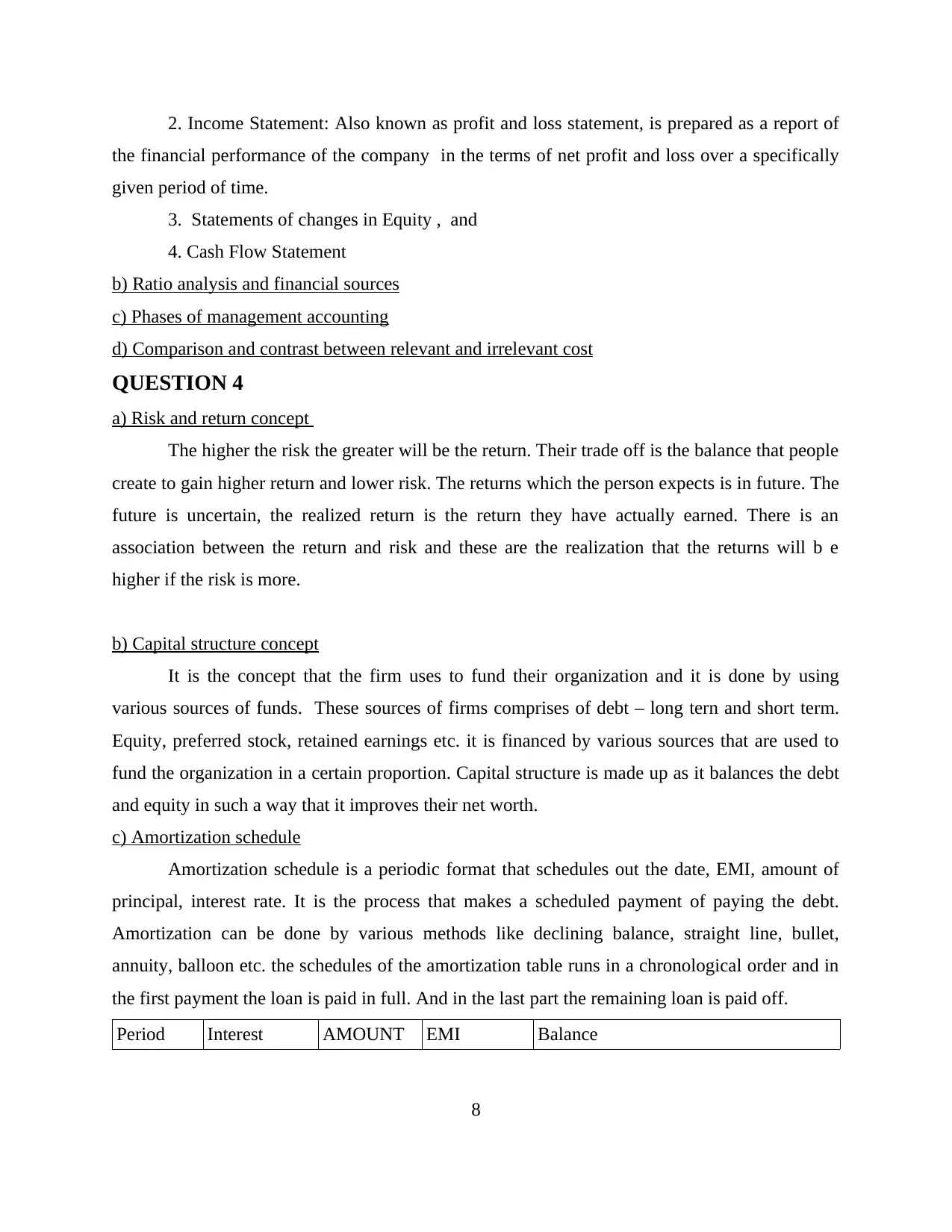
2. Income Statement: Also known as profit and loss statement, is prepared as a report of
the financial performance of the company in the terms of net profit and loss over a specifically
given period of time.
3. Statements of changes in Equity , and
4. Cash Flow Statement
b) Ratio analysis and financial sources
c) Phases of management accounting
d) Comparison and contrast between relevant and irrelevant cost
QUESTION 4
a) Risk and return concept
The higher the risk the greater will be the return. Their trade off is the balance that people
create to gain higher return and lower risk. The returns which the person expects is in future. The
future is uncertain, the realized return is the return they have actually earned. There is an
association between the return and risk and these are the realization that the returns will b e
higher if the risk is more.
b) Capital structure concept
It is the concept that the firm uses to fund their organization and it is done by using
various sources of funds. These sources of firms comprises of debt – long tern and short term.
Equity, preferred stock, retained earnings etc. it is financed by various sources that are used to
fund the organization in a certain proportion. Capital structure is made up as it balances the debt
and equity in such a way that it improves their net worth.
c) Amortization schedule
Amortization schedule is a periodic format that schedules out the date, EMI, amount of
principal, interest rate. It is the process that makes a scheduled payment of paying the debt.
Amortization can be done by various methods like declining balance, straight line, bullet,
annuity, balloon etc. the schedules of the amortization table runs in a chronological order and in
the first payment the loan is paid in full. And in the last part the remaining loan is paid off.
Period Interest AMOUNT EMI Balance
8
the financial performance of the company in the terms of net profit and loss over a specifically
given period of time.
3. Statements of changes in Equity , and
4. Cash Flow Statement
b) Ratio analysis and financial sources
c) Phases of management accounting
d) Comparison and contrast between relevant and irrelevant cost
QUESTION 4
a) Risk and return concept
The higher the risk the greater will be the return. Their trade off is the balance that people
create to gain higher return and lower risk. The returns which the person expects is in future. The
future is uncertain, the realized return is the return they have actually earned. There is an
association between the return and risk and these are the realization that the returns will b e
higher if the risk is more.
b) Capital structure concept
It is the concept that the firm uses to fund their organization and it is done by using
various sources of funds. These sources of firms comprises of debt – long tern and short term.
Equity, preferred stock, retained earnings etc. it is financed by various sources that are used to
fund the organization in a certain proportion. Capital structure is made up as it balances the debt
and equity in such a way that it improves their net worth.
c) Amortization schedule
Amortization schedule is a periodic format that schedules out the date, EMI, amount of
principal, interest rate. It is the process that makes a scheduled payment of paying the debt.
Amortization can be done by various methods like declining balance, straight line, bullet,
annuity, balloon etc. the schedules of the amortization table runs in a chronological order and in
the first payment the loan is paid in full. And in the last part the remaining loan is paid off.
Period Interest AMOUNT EMI Balance
8
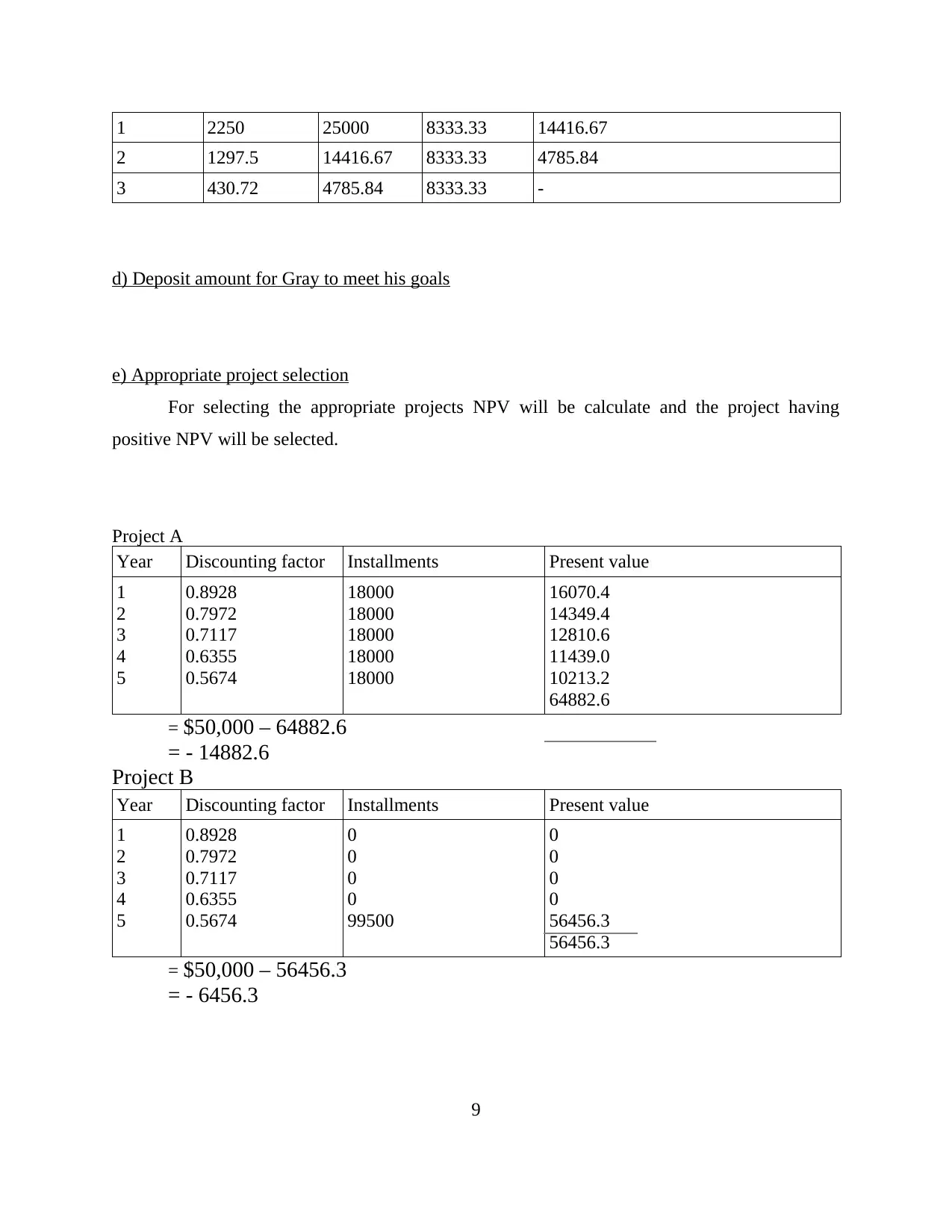
1 2250 25000 8333.33 14416.67
2 1297.5 14416.67 8333.33 4785.84
3 430.72 4785.84 8333.33 -
d) Deposit amount for Gray to meet his goals
e) Appropriate project selection
For selecting the appropriate projects NPV will be calculate and the project having
positive NPV will be selected.
Project A
Year Discounting factor Installments Present value
1
2
3
4
5
0.8928
0.7972
0.7117
0.6355
0.5674
18000
18000
18000
18000
18000
16070.4
14349.4
12810.6
11439.0
10213.2
64882.6
= $50,000 – 64882.6
= - 14882.6
Project B
Year Discounting factor Installments Present value
1
2
3
4
5
0.8928
0.7972
0.7117
0.6355
0.5674
0
0
0
0
99500
0
0
0
0
56456.3
56456.3
= $50,000 – 56456.3
= - 6456.3
9
2 1297.5 14416.67 8333.33 4785.84
3 430.72 4785.84 8333.33 -
d) Deposit amount for Gray to meet his goals
e) Appropriate project selection
For selecting the appropriate projects NPV will be calculate and the project having
positive NPV will be selected.
Project A
Year Discounting factor Installments Present value
1
2
3
4
5
0.8928
0.7972
0.7117
0.6355
0.5674
18000
18000
18000
18000
18000
16070.4
14349.4
12810.6
11439.0
10213.2
64882.6
= $50,000 – 64882.6
= - 14882.6
Project B
Year Discounting factor Installments Present value
1
2
3
4
5
0.8928
0.7972
0.7117
0.6355
0.5674
0
0
0
0
99500
0
0
0
0
56456.3
56456.3
= $50,000 – 56456.3
= - 6456.3
9
⊘ This is a preview!⊘
Do you want full access?
Subscribe today to unlock all pages.

Trusted by 1+ million students worldwide
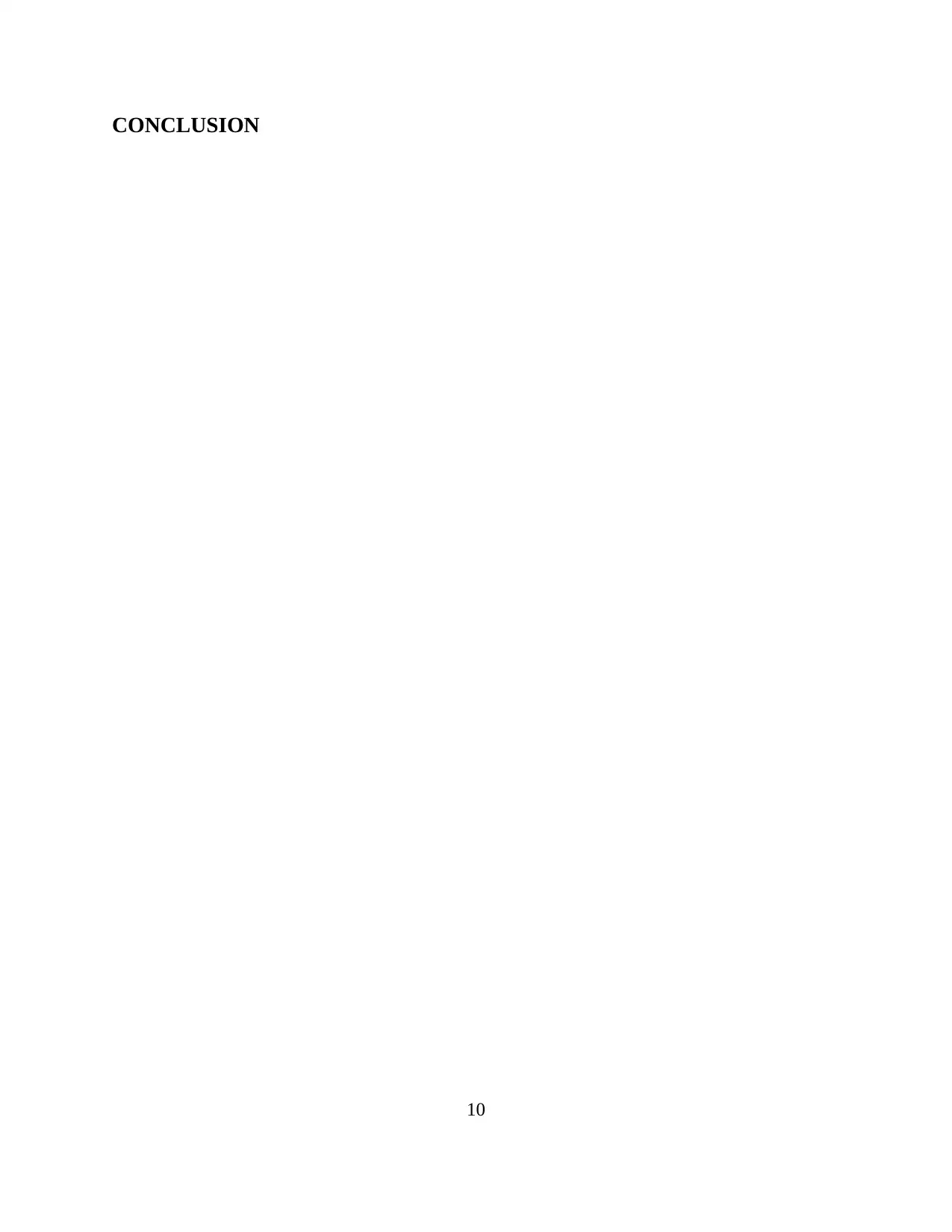
CONCLUSION
10
10
Paraphrase This Document
Need a fresh take? Get an instant paraphrase of this document with our AI Paraphraser
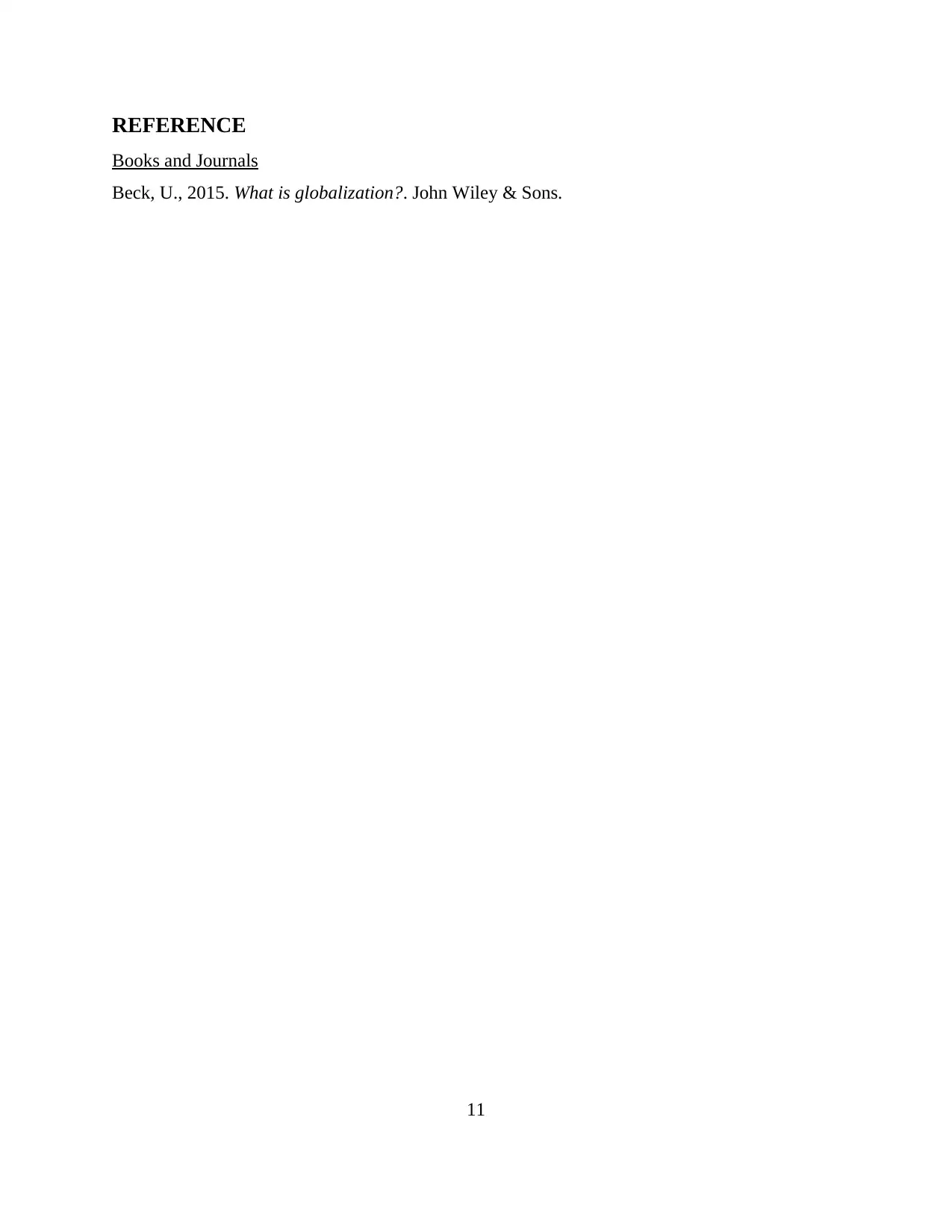
REFERENCE
Books and Journals
Beck, U., 2015. What is globalization?. John Wiley & Sons.
11
Books and Journals
Beck, U., 2015. What is globalization?. John Wiley & Sons.
11
1 out of 11
Related Documents
Your All-in-One AI-Powered Toolkit for Academic Success.
+13062052269
info@desklib.com
Available 24*7 on WhatsApp / Email
![[object Object]](/_next/static/media/star-bottom.7253800d.svg)
Unlock your academic potential
Copyright © 2020–2025 A2Z Services. All Rights Reserved. Developed and managed by ZUCOL.





